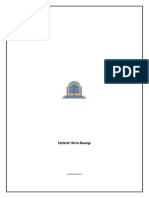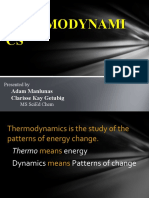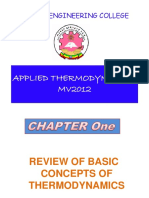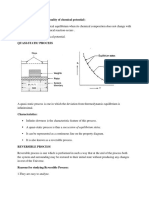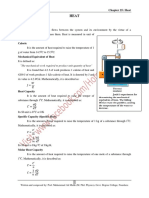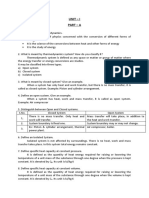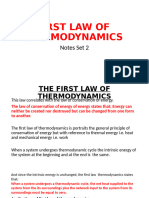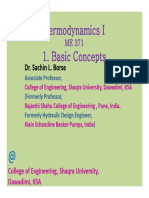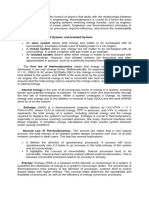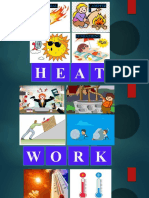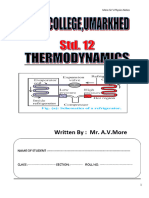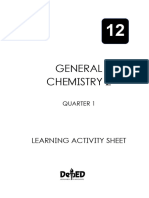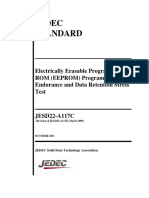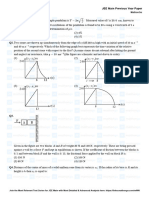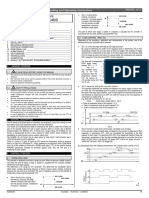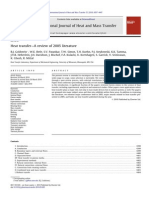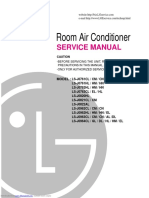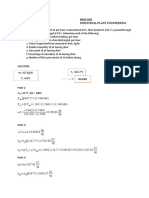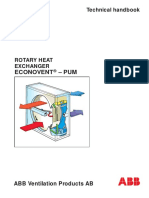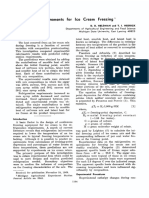UnitII-Fundamentals of Thermodynamics
UnitII-Fundamentals of Thermodynamics
Uploaded by
Bishwas GautamCopyright:
Available Formats
UnitII-Fundamentals of Thermodynamics
UnitII-Fundamentals of Thermodynamics
Uploaded by
Bishwas GautamCopyright
Available Formats
Share this document
Did you find this document useful?
Is this content inappropriate?
Copyright:
Available Formats
UnitII-Fundamentals of Thermodynamics
UnitII-Fundamentals of Thermodynamics
Uploaded by
Bishwas GautamCopyright:
Available Formats
UNIT II: FUNDAMENTALS OF THERMODYNAMICS AND HEAT
TRANSFER
Objective: Obtain a basic understanding of thermodynamics and heat transfer.
2.1. Thermodynamics
Thermodynamics is a branch of physics that deals with the relationship between heat, work,
and energy. It is the study of heat and its relationship to motion and forces. Thermodynamics
is mainly concerned with:
a. How is energy converted from one form to another?
b. How is energy transferred between different systems?
c. How does the transformation and transfer of energy affect the motion and behavior of
matter?
Internal Energy
Internal Energy can be defined as the sum of the microscopic kinetic and potential energies of
the particles within a system. It is a thermodynamic property that depends on the temperature
of the system. It represents the total energy stored within the system.
When energy is added to the system, its internal energy increases, and when energy is removed,
its internal energy decreases.
Control Volume and Control Mass System
Figure 6. Difference between closed and open systems
A closed volume system, also known as a control volume or an open system, refers to a region
in space with fixed boundaries, which allows for the transfer of mass and energy across its
boundaries. Examples: Heat Exchangers, Turbines, etc.
A closed mass system, also known as isolated system or a closed system, refers to a system
with fixed mass. The boundaries of the system are not necessarily fixed and can vary depending
on the analysis being done. Examples: Sealed containers or vessels.
2.1.1. First Law of Thermodynamics
The first law of thermodynamics is a fundamental principle in energy engineering that states
that energy is conserved within a closed system. It is equivalent to the law of conservation of
energy, which states that energy can neither be created nor be destroyed; it can only be changed
from one form to another.
Introduction to Energy Engineering MEC 114 P. Timilsina
In thermodynamic formulation, it can be stated as, “The amount of heat added to a system is
equal to the change in internal energy and workdone by system.”
∆𝑈 = 𝑄 − 𝑊
Where, ∆𝑈 = Change in Internal Energy, Q = Heat transferred into the system and W = Work
done by the system.
Example: Let us imagine a cylinder with a sealed piston containing some
Gas within the system. Since the system is a sealed container, it is a
closed system. So, we can apply the first law of thermodynamics to the
system.
Case I:
Let us assume we heat the cylinder with an external energy source with
Q = 600 J. Since we are adding energy to the system, this heat added
becomes positive. Now, if the piston is kept free, when the
thermodynamic state of the gas inside the cylinder changes, the gas
expands moving the piston upwards. This is work done by gas. So, it is
taken as positive. Let us assume the work done due to
displacement of the piston is 300J.
Then, ∆𝑈 = 600 − 300 = 300 𝐽
Case II:
Let us assume that, in addition to the heat addition of 600J, we are pressing the piston from
above to move the piston downwards such that work done is equal to 300J. However, this time
the work is not done by the gas, instead the work is done on the gas and taken as negative.
Then, ∆𝑈 = 600 + 300 = 900 𝐽
Limitations of First Law
The first law does not provide information about the direction in which a process will occur. It
only states that energy is conserved but does not indicate whether the process is feasible or the
extent to which it will occur spontaneously.
Suppose we have a container containing ice at 0 degrees Celsius and water at 20 degrees
Celsius. We assume that we extract a certain amount of heat from the ice, causing its
temperature to decrease to -1 degree Celsius. We then use that heat to raise the temperature of
the water to, let's say, 20.5 degrees Celsius. From the perspective of the First Law of
Thermodynamics, energy transfer is balanced. The heat extracted from the ice is equal to the
heat absorbed by the water. Therefore, the First Law is satisfied as energy is conserved.
However, in reality, this process will not occur spontaneously. In this example, it is highly
unlikely that the ice would spontaneously cool to -1 degree Celsius while simultaneously
heating the water to a higher temperature. Thus, we need the second law of thermodynamics to
define the direction of heat transfer.
Introduction to Energy Engineering MEC 114 P. Timilsina
2.1.2. Energy Balance
Energy balance involves accounting for all forms of energy entering and leaving a system to
ensure that energy is conserved. This allows engineers to assess the efficiency of processes,
evaluate the performance of systems, and identify potential energy losses and gains.
Applications of energy balance:
a. Power Generation: Energy balance is used to analyze power generation systems, such as
thermal power plants. It helps to determine the efficiency of energy conversion processes
and assess the losses due to different factors.
b. Heat Transfer: Energy balance enables us to calculate heat transfer rates, assess temperature
distributions, and design better heat exchangers.
Example 1: A sealed container is filled with gas initially containing 2545 J of energy. After
0.26 KJ of heat is added to the system, the internal energy increases by 455 J. How much
work was done on or by the gas?
Solution:
According to the First Law of Thermodynamics, ∆𝑈 = 𝑄 − 𝑊
∆𝑈 = 455 𝐽 𝑎𝑛𝑑 𝑄 = 260 𝐽
Hence, 455 = 260 – W
Which gives, W = -195 J.
Hence, 195 J of work is done on the gas.
Example 2: A rigid tank contains a hot fluid that is cooled while stirred by a paddle wheel.
Initially, the internal energy of the fluid is 800 KJ. During the cooling process, the fluid
loses 500 KJ of heat, and the weight of 500 Kg goes down by 10 meters. Determine the
final internal energy of the fluid.
Solution:
The weight on the paddle does work on the
fluid.
Work done on the fluid (W) = F*d = mg *d =
500 * 10 * 10 = - 50 KJ.
Also, U1 = 800 KJ, Q = -500 KJ
Then, according to the First Law of
Thermodynamics, ∆𝑈 = 𝑄 − 𝑊
U2 – 800 = -500 - (-50)
Hence, Final Internal Energy (U2) = 350 KJ
2.1.3. Second Law of Thermodynamics
The second Law of Thermodynamics states that heat always flows from hotter objects to colder
objects unless energy in some form is applied to reverse the direction of the flow.
Introduction to Energy Engineering MEC 114 P. Timilsina
Entropy: Entropy is that concept in thermodynamics that quantifies the level of disorder or
randomness in a system. In natural processes, over time, the system becomes more random,
resulting in an increase in entropy.
Using the Second law of thermodynamics, we proved that hot tea can only release heat and not
absorb heat.
So, the second law of thermodynamics can also be stated as: "In any spontaneous process, the
total entropy of an isolated system always increases over time."
Questions Addressed above:
1. Explain the role of Entropy and its connection to the direction of the process.
2. Discuss how the increase in entropy reflects the irreversibility of natural processes.
3. Explain how the processes that increase entropy are spontaneous, while those that decrease
entropy require external intervention.
Reversible and Irreversible Processes based on Entropy:
For any process between State 1 and State 2, according to the second law of thermodynamics,
during any real process, the net entropy change is always greater than or equal to zero. i.e.,
𝑆2 ≥ 𝑆1
During any process, if 𝑆2 = 𝑆1, the reverse process is also possible because the entropy is the
same for both forward and reverse directions. Hence, the process is called a reversible process.
But during any process, if 𝑆2 > 𝑆1 , i.e., entropy increases in the forward direction, then the
reverse direction is not possible because any real process can not result in a decrease in entropy.
Hence the process is called an irreversible process.
Introduction to Energy Engineering MEC 114 P. Timilsina
A process is said to be a reversible process if the initial conditions of both the system and
surroundings can be restored by the reverse action such that the net change in entropy is zero
for both the forward and reverse processes.
A process is said to be irreversible process if the initial conditions of both the system and
surroundings cannot be restored (certain effects are left either on the system or on the
surroundings) by the reverse action. In this case, the entropy of the system increases in the
forward process and therefore reverse direction is not possible.
Isentropic Process:
𝒅𝑸
The change in entropy of any system is given by: 𝒅𝑺 = 𝑻
If the process is reversible as well as adiabatic (𝒅𝑸 = 𝟎), we get, 𝒅𝑺 = 𝟎.
That means, 𝑺𝟐 − 𝑺𝟏 = 𝟎
𝑺𝟐 = 𝑺𝟏
Hence, during a reversible and adiabatic process, entropy of the system remains constant, and
the process is called an isentropic process.
Carnot Cycle, Heat Engine, Heat Pump and Refrigerator:
[Extra Reading Material: Important for Practical Lab and understanding of later topics]
a. Carnot Cycle
Carnot cycle is an ideal cycle devised by Carnot which will have efficiency equal to that of a
reversible cycle (theoretical maximum) without considering its mechanical details. The cycle
is practically not possible. However, it is used as a reference standard for the comparison of
different practical cycles. Carnot cycle consists of the following processes in series as shown:
Process 1-2: Isothermal Heat Addition
Process 2-3: Isentropic Expansion
Process 3-4: Isothermal Heat Rejection
Process 4-1: Isentropic Compression
Introduction to Energy Engineering MEC 114 P. Timilsina
Figure 7. Carnot Cycle
Figure 8. P-V (Left) and T-S (Right) Diagrams for Carnot Cycle
b. Heat Engine
Heat Engines are the devices which operate on cyclic processes and convert heat energy into
mechanical work. Heat engine takes QH amount of heat from a high temperature reservoir at
TH (source), converts some part of it into work (W) and rejects remaining part (QL) to a low
reservoir at TL (sink).
Introduction to Energy Engineering MEC 114 P. Timilsina
Figure 9. Schematic Representation of a Heat Engine
Efficiency of a heat engine is defined by the ratio of work output and heat supplied.
𝑊 𝑄𝐻 − 𝑄𝐿 𝑄𝐿
𝜂= = =1−
𝑄𝐻 𝑄𝐻 𝑄𝐻
𝑄𝐻 𝑄
For a reversible cycle, 𝑑𝑆 = 0 = − 𝑇𝐿
𝑇𝐻 𝐿
𝑄 𝑄𝐿
Or 𝑇 𝐻 =
𝐻 𝑇𝐿
𝑄 𝑇
Or 𝑄 𝐿 = 𝑇 𝐿
𝐻 𝐻
Hence,
𝑻𝑳
𝜼𝒄𝒂𝒓𝒏𝒐𝒕 = 𝟏 −
𝑻𝑯
𝑄 𝑄
However, for an irreversible engine, 𝑑𝑆 > 0, which gives, 𝑇 𝐻 − 𝑇 𝐿 > 0.
𝐻 𝐿
𝑄 𝑇
Which gives, 𝑄 𝐿 < 𝑇 𝐿
𝐻 𝐻
Hence,
𝑻𝑳
𝜼𝒊𝒓𝒓𝒆𝒗𝒆𝒓𝒔𝒊𝒃𝒍𝒆 < 𝟏 −
𝑻𝑯
c. Heat Pump
Heat Pump is a device operating on a cyclic process, which takes heat from a low temperature
reservoir at TL (Surroundings) and delivers it to a high temperature TH (desired space) with the
help of external work.
Introduction to Energy Engineering MEC 114 P. Timilsina
Figure 10. Schematic Representation of Heat Pump
Performance of a heat pump is measured by its coefficient of performance, which is defined as
the ratio of desired effect and the work supplied.
𝑄𝐻 1
𝐶𝑂𝑃𝐻𝑃 = =
𝑊 1 − 𝑄𝐿
𝑄 𝐻
For reversible heat pump,
1 𝑇𝐻
𝐶𝑂𝑃𝑟𝑒𝑣,𝐻𝑃 = =
𝑇𝐿 𝑇𝐻 − 𝑇𝐿
1−
𝑇𝐻
For irreversible heat pump,
𝑇𝐻
𝐶𝑂𝑃𝑖𝑟𝑟𝑒𝑣,𝐻𝑃 <
𝑇𝐻 − 𝑇𝐿
d. Refrigerator
A refrigerator is a device, operating on a cyclic process, which takes heat from a low
temperature reservoir at TL (desired space) and delivers it to a high temperature TH
(surroundings) with the help of external work.
Performance of a refrigerator is also measured by its coefficient of performance, which is
defined as the ratio of desired effect and the work supplied.
𝑄𝐿 𝑄𝐿 1
𝐶𝑂𝑃𝑅 = = =
𝑊 𝑄𝐻 − 𝑄𝐿 𝑄𝐻 − 1
𝑄𝐿
For reversible heat pump,
1 𝑇𝐿
𝐶𝑂𝑃𝑟𝑒𝑣,𝑅 = =
𝑇𝐻 𝑇𝐻 − 𝑇𝐿
𝑇𝐿 − 1
Introduction to Energy Engineering MEC 114 P. Timilsina
For irreversible heat pump,
𝑇𝐿
𝐶𝑂𝑃𝑖𝑟𝑟𝑒𝑣,𝑅 <
𝑇𝐻 − 𝑇𝐿
Figure 11. Schematic Representation of Refrigerator
Also, we get,
𝐶𝑂𝑃𝐻𝑃 − 𝐶𝑂𝑃𝑅 = 1
2.1.4. Steady Flow Energy Process and Devices
What is steady flow energy equation? Describe the terms in the equation.
The steady flow energy equation is a thermodynamic equation that relates the energy of a fluid
as it flows through a system under steady conditions. The equation is generally written per unit
mass and is used to analyze open systems where fluid flows at a constant rate, heat transfer
occurs, and external work is done, all under steady conditions. The equation is expressed as
follows:
q - w = h2 - h1 + (v2^2 - v1^2)/2 + g(z2 - z1)
where:
q is the heat transfer across the boundary per unit mass
w is the external work done by the system per unit mass
h is the fluid enthalpy
v is the fluid velocity
g is the acceleration due to gravity
z is the fluid height
The terms in the equation are defined as follows:
Heat transfer (q): The amount of heat transferred across the boundary per unit mass.
Introduction to Energy Engineering MEC 114 P. Timilsina
External work (w): The amount of work done by the system per unit mass.
Enthalpy (h): The total energy of the fluid per unit mass, including internal energy, pressure
energy, and kinetic energy.
Velocity (v): The speed of the fluid.
Acceleration due to gravity (g): The acceleration experienced by the fluid due to gravity.
Height (z): The height of the fluid above a reference plane.
The steady flow energy equation is used to analyze a variety of systems, such as gas turbines,
jet engines, and refrigeration systems. It is an essential tool for engineers to design and optimize
these systems. By understanding the terms in the equation, engineers can identify the sources
and sinks of energy in the system and determine the efficiency of the system.
A steady state process refers to a thermodynamic process in which the operating conditions
within a system remain constant over time. In such processes, the properties of the fluid flowing
through the system, such as temperature, pressure, and velocity, do not change significantly at
any point within the system.
Flow processes are such processes where there is flow of fluid/material to and from the system,
whereas non-flow processes have no flow (control mass).
Control Volume Applications or Control Volume Devices:
Operation and performance of common devices such as turbines, compressors, fan, nozzle, heat
exchanger, etc. can be studied with reference to mass conservation and energy conservation
equations discussed earlier. Depending upon their operation and function, common control
volume applications can be classified into four groups:
a. Steady State Work Applications: Devices which operate under steady state conditions
and either produce or consume work are called steady state work applications. Common
examples of steady state work applications are turbine, compressor, pump, fan, etc.
b. Steady State Flow Applications: Devices which operate under steady state
conditions and do not produce or consume work are called steady state flow
applications. Common examples of steady state flow applications are nozzle,
diffuser, heat exchanger, evaporator, condenser, throttling valves, etc.
c. Unsteady State Work Applications: Turbine, compressor, pump, etc. operate at steady
state at their normal operation. But the same devices operate at unsteady state during
the startup and shut down period.
d. Unsteady State Flow Applications: Let us take an example of a cooking cylinder.
During the cooking process, the gas is consumed, and mass of the system continuously
decreases, and it does not produce any boundary work. Therefore, it is an unsteady state
flow application.
We only need to study Steady State Flow Energy Process and applications.
2.1.5. Heat Exchangers
A heat exchanger is a device used to transfer heat from one fluid to another. Schematic
representation of a heat exchanger is shown in the figure below, where 1h is inlet of hot fluid,
2h is outlet of hot fluid, 1c is inlet of cold fluid, and 2c is outlet of cold fluid.
Introduction to Energy Engineering MEC 114 P. Timilsina
Figure 12. Heat Exchanger
Extra Note:
Enthalpy: It is a fundamental property in thermodynamics that measures the total energy
content of a system. It combines the internal energy of the system with the energy associated
with the system’s pressure and volume. Enthalpy is denoted by the symbol “H”.
Enthalpy is defined as the sum of the internal energy (U) and the product of pressure (P) and
volume (V):
H = U + PV
The enthalpy change (ΔH) during a process is equal to the heat transferred (Q) at constant
pressure:
ΔH = Q
To determine the magnitude of net heat exchange 𝑄̇ , we can analyze either control volume A
or control volume B. If we have to study the effect of heat exchange on the properties of hot or
cold fluid, we can analyze the control volume C. In the case of heat exchanger, changes in
potential energy and kinetic energy are negligible in comparison to the change in enthalpy.
Therefore, energy equation for the control volume A is given as:
𝑄̇ = 𝑚̇ ℎ (ℎ2ℎ − ℎ1ℎ )
Where 𝑚̇ℎ is the mass flow rate of hot fluid, ℎ1ℎ is the enthalpy of hot fluid at inlet and ℎ2ℎ is
the enthalpy of hot fluid at outlet.
Similarly, energy equation for control volume C is given as:
𝑚̇ ℎ ℎ1ℎ + 𝑚̇ 𝑐 ℎ1𝑐 = 𝑚̇ ℎ ℎ2ℎ + 𝑚̇ ℎ ℎ2𝑐
Where 𝑚̇ 𝑐 is the mass flow rate of cold fluid, ℎ1𝑐 is the enthalpy of cold fluid at inlet and ℎ2𝑐
is the enthalpy of cold fluid at outlet.
Evaporator and condenser are special types of heat exchangers. Evaporator converts liquid into
vapor by absorbing heat from the surroundings whereas condenser converts vapor into liquid
by rejecting heat to the surroundings. Energy equation for the evaporator or condenser is given
as:
𝑄̇ = 𝑚̇(ℎ2 − ℎ1 )
Schematic representations of evaporator and condenser are as below.
Introduction to Energy Engineering MEC 114 P. Timilsina
Figure 13. Schematic Representation of Condenser (Left) and Evaporator (Right)
2.1.6. Throttling Process
A throttling process is a thermodynamic process in which a fluid undergoes a significant
pressure drop without any heat transfer to or from the surroundings. It is also called an adiabatic
throttling process or Joule-Thomson Expansion. The throttling valve reduces pressure of the
fluid without performing work. Heat transfer, change in potential and kinetic energy are also
negligible. Energy equation for the throttling valve or throttling process is:
ℎ2 − ℎ1 = 0
Hence, enthalpy remains constant during a throttling process. So, it is called an isenthalpic
process. Examples of throttling devices are: Capillary tube, small orifice, Porous Plug, Partially
Open valve, etc.
Figure 14. Schematic Representation of Throttling Valve
Saturation Dome
Figure 15. Saturation Dome
Introduction to Energy Engineering MEC 114 P. Timilsina
2.1.7. Refrigeration Cycles
Vapor Compression Refrigeration Cycle
Vapor Compression refrigeration cycle is the most commonly used cycle of heating and cooling
of the desired space. The working substance used to run the cycle is called a refrigerant.
The major components of the vapor compression refrigeration cycle are shown below:
Figure 16. Schematic of Vapor Compression Refrigeration Cycle
Exit vapor from the evaporator is supplied to the compressor, where it is compressed with the
help of work input usually provided by the electricity. The compression process is assumed to
be an isentropic process, during which pressure, temperature, and enthalpy of the refrigerant
increase while its entropy remains constant.
The high pressure and high temperature refrigerant from the compressor outlet is delivered to
the condenser. Condenser can interact with its surroundings and the high temperature
refrigerant rejects heat to the surroundings. While rejecting heat vapor at the condenser inlet
gets condensed. Condensation process occurs at constant pressure, during which entropy and
enthalpy of the refrigerant decreases.
The high-pressure liquid at the exit of the condenser is delivered to the expansion (throttling)
valve. During the throttling process, enthalpy of the refrigerant remains constant, its pressure
and temperature decreases and entropy increases.
The low pressure and low temperature refrigerant from the expansion valve enters into the
evaporator. The low temperature refrigerant inside the evaporator can take heat from its
surroundings. During the absorption of heat, refrigerant gets evaporated. Evaporation process
takes place at constant pressure during which entropy and enthalpy of the refrigerant increases.
Introduction to Energy Engineering MEC 114 P. Timilsina
Figure 17. P-h Diagram for Vapor Compression Refrigeration Cycle
Figure 18. T-S diagram for Vapor Compression Refrigeration Cycle
If the cycle is used for the heating of a desired space, then its COP is given as:
𝑄𝐻 ℎ2 − ℎ3
𝐶𝑂𝑃𝐻𝑃 = =
𝑊 ℎ2 − ℎ1
If the cycle is used for the cooling of a desired space, then its COP is given as:
𝑄𝐿 ℎ1 − ℎ4
𝐶𝑂𝑃𝑅 = =
𝑊 ℎ2 − ℎ1
2.2. Modes of Heat Transfer
Heat transfer is the transfer of heat energy because of the temperature difference. According to
the physical mechanism and the governing law associated with them, heat transfer can be
classified into three modes:
a. Conduction
b. Convection
c. Radiation
Introduction to Energy Engineering MEC 114 P. Timilsina
2.2.1. Conduction
The mode of heat transfer that occurs through a solid or stationary medium without the bulk
movement of the medium itself is called conduction. The heat is transferred by means of
molecular or electronic interaction. The heat transfer is driven by temperature gradients within
the medium, where heat is transferred from higher temperature regions to lower temperature
regions.
Mechanism:
Conduction involves the transfer of heat through direct physical contact between neighboring
molecules or particles in a solid material. The higher-energy particles transfer their energy to
adjacent lower-energy particles, causing a progressive transfer of heat.
Question: How does heat conduction occur in metals? Describe the mechanism.
Heat conduction in metal occurs primarily through the movement of free electrons. In metals,
the outermost electrons of the atoms are loosely bound and can move freely within the crystal
lattice. The mobile electrons are known as free electrons and are responsible for the high
electrical and thermal conductivity of metals.
When a temperature difference is applied across a metal, the hotter end of the metal gains
thermal energy, which excites the atoms and causes them to vibrate more vigorously. These
vibrations are transferred to the neighboring atoms through collisions, leading to a chain
reaction of energy transfer. The free electrons, being highly mobile, also participate in this
energy transfer process. They move rapidly throughout the metal, colliding with atoms and
transferring their kinetic energy. These collisions result in the transfer of energy from the hot
region to the cooler region of the metal.
The movement of free electrons is the primary mechanism of heat conduction in metals and
contributes significantly to their high thermal conductivity. Compared to other materials, such
as insulators, metals have a large number of free electrons available for heat transfer, allowing
for efficient conduction of heat.
Governing Law:
Magnitude of conduction heat transfer is given by Fourier Equation:
𝑑𝑇
𝑄̇ = −𝑘𝐴
𝑑𝑥
Where, 𝑄̇ is the heat transfer rate (W),
𝑊
k is the thermal conductivity of the material (𝑚𝐾),
A is the cross-sectional area of the material normal to the direction of heat flow (m2), and
𝑑𝑇 𝐾
is the temperature gradient within the material (𝑚).
𝑑𝑥
The negative sign indicates that heat flows in the direction of decreasing temperature.
Introduction to Energy Engineering MEC 114 P. Timilsina
2.2.2. Convection
Convection is a mode of heat transfer that involves the movement of a fluid (liquid and gas).
The heat transfer occurs due to the combined effects of conduction heat transfer and fluid
motion.
Mechanism:
In convection, heat transfer occurs through the bulk movement of fluid molecules of particles.
When a fluid is heated, it becomes less dense and rises, creating a flow pattern that transfers
heat from the hotter regions to the cooler regions. Heat transfer can occur through natural (free)
convection or forced convection.
Natural convection occurs when the fluid motion is driven by density differences resulting from
temperature variations. It is commonly observed in situations where heated fluids rise and
cooler fluids sink, creating natural circulation patterns.
Forced convection involves the use of external means, such as fans or pumps, to induce fluid
motion and enhance heat transfer. It is commonly employed in applications where there is a
need for increased heat transfer rates.
Governing Law:
Magnitude of convection heat transfer is given by Newton’s law of cooling.
𝑄̇ = ℎ. 𝐴(𝑇𝑠 − 𝑇∞ )
Where, 𝑄̇ is the heat transfer rate (W),
𝑊
h is the convection heat transfer coefficient (𝑚2 .𝐾),
A is the surface area of the solid confining the liquid (m2),
𝑇𝑠 is the solid surface temperature (𝐾), and
𝑇∞ is the free stream temperature of the fluid (𝐾).
The heat transfer coefficient h depends on the thermodynamic and transport properties (e.g.,
density, viscosity, specific heat, and thermal conductivity of the fluid), the geometry of the
surface, the nature of the fluid flow, and prevailing thermal conditions.
2.2.3. Radiation
Radiation is a mode of heat transfer that does not require any medium for energy transfer. The
heat transfer occurs in the form of electromagnetic waves.
Mechanism:
Radiation occurs due to the emission, absorption, and transmission of electromagnetic waves,
which can travel through a vacuum or transparent media. Heat energy is transferred when these
waves are emitted by a hotter object and absorbed by a cooler object.
Governing Law:
The magnitude of radiation heat transfer between two practical bodies at temperatures T1 and
T2 is given by Stefan-Boltzmann law.
Introduction to Energy Engineering MEC 114 P. Timilsina
𝑄̇ = 𝜖𝜎𝐴(𝑇1 4 − 𝑇2 4 )
Where, 𝑄̇ is the heat transfer rate (W),
𝜖 is the emissivity,
A is the surface area (m2), and
𝜎 is the Stefan-Boltzmann constant = 6.67 × 10−8 𝑊 ⁄𝑚2 𝐾 4 .
The equation shows that the rate of heat transfer by radiation is proportional to the fourth power
of the temperature difference between the objects and is affected by the emissivity of the
objects and their surface areas.
When the radiation falls on a body, some parts of the incidence radiation are absorbed by the
body, a part are reflected and the remaining are transmitted through the body. The sum of
absorptivity, reflectivity and transmittivity is unity.
Black body: It absorbs all the incident radiation. Therefore, absorptivity is unity and
reflectivity and transmittivity are zero.
White body: It reflects all the incident radiation. Therefore, reflectivity is unity and
absorptivity and transmittivity are zero.
Transparent body: It transmits all the incident radiation. Therefore, transmittivity is unity and
absorptivity and reflectivity are zero.
Opaque body: It doesn’t transmit the incident radiation. Therefore, transmittivity is zero and
the sum of absorptivity and reflectivity are unity.
Example1: A furnace wall is made of 20 cm of magnesite brick and 20 cm of common
brick. The magnesite brick is exposed to hot gases at 1200°C and the common brick outer
surface is exposed to 35°C room air. The surface heat transfer coefficient of the interior
wall is 40 W/m2K and that of the outside wall is 20 W/m2K respectively. Thermal
conductivities of magnesite and common brick are 4 and 0.5 W/mK respectively.
Determine:
a. heat loss per unit area of the furnace wall and (2219.05 W/m2)
b. maximum temperature to which common brick is subjected. (1033.57°C)
Introduction to Energy Engineering MEC 114 P. Timilsina
Radial Heat Conduction:
When the heat is flowing radially outwards or inwards, we need to calculate the rate of heat
transfer by using the Fourier’s law as below:
We have Fourier’s law:
Introduction to Energy Engineering MEC 114 P. Timilsina
In this case, the area normal to the direction of heat flow is given by the curved surface area of
the cylinder. Therefore, substituting A = 2πrL in the above equation, we get,
Rearranging the above equation,
Integrating with associated boundary conditions,
Solving, we get the magnitude of radial heat conduction through a hollow cylinder:
Example Question: A steel pipe with ID and OD as 80mm and 120mm is covered with
two layers of insulation, 25mm and 40mm thick. The thermal conductivities of insulating
materials are 0.2 W/mK and 0.1 W/mK respectively while that of steel is 50 W/mK. The
inner surface of the pipe is 200°C while surface temperature of insulation is 40°C.
Determine the heat loss from the unit length of the pipe and layer contact temperatures.
Solution:
Given: Inner radius of pipe: r1 = 40mm
Outer radius of pipe: r2 = 60mm
Outer radius of first insulator: r3 = 60+25 = 85mm
Outer radius of second insulator: r4 = 85+40 = 125mm
Thermal conductivity of pipe: k1 = 50 W/mK
Thermal conductivity of first insulator: k2 = 0.2 W/mK
Thermal conductivity of second insulator: k3 = 0.1 W/mK
Inner surface temperature: T1 = 200°C
Introduction to Energy Engineering MEC 114 P. Timilsina
Outer surface temperature: T1 = 40°C
Now, heat transfer per unit length of the composite cylinder is given by:
Applying heat transfer equation for steel pipe only,
Now, rearranging for T2,
, which gives, T2 = 199.769°C
Again, applying the above equation for T3,
Introduction to Energy Engineering MEC 114 P. Timilsina
2.3. Building Heat Transfer
Heat transfer in buildings is a key aspect of energy management and optimizing thermal
comfort. Buildings experience heat gain or loss through various mechanisms, and
understanding these processes helps in efficient energy utilization. Efficient heat transfer
management leads to reduced energy consumption, lower utility bills, and improved
sustainability.
Insulation materials and building envelope design play a crucial role in reducing heat transfer.
Effective insulation reduces heat flow between indoor and outdoor environments, ensuring
stable indoor temperatures. A well-designed building envelope prevents air leakage and
minimizes thermal bridging, enhancing energy efficiency.
Background:
Thermal Conductivity (k): It is the amount of heat that will flow through a unit area of a
material of unit thickness per unit time, when the difference of two temperatures is
maintained at 1°C.
Thermal Resistivity (1/K): Reciprocal of Thermal conductivity.
Thermal Resistance (R)
Thermal Resistance or R-value is a material’s ability to resist heat transfer. It is a property that
is particularly assigned to insulation materials, walls, roofs, and windows, indicating their
thermal resistance. Higher R-values indicate greater resistance to heat flow, implying better
insulation.
Thermal resistance (R) is determined by dividing the thickness of a material by its thermal
conductivity.
𝐿
𝑅= 𝑚2 𝐾 ⁄𝑊
𝐾
R-value serves as a standardized measure for comparing insulation materials and components.
It allows builders and designers to select suitable materials that provide adequate insulation.
1 1
Total Thermal Resistance, 𝑅𝑇 = 𝑓 + 𝑓 + 𝑅1 + 𝑅2 + 𝑅3 + ⋯
𝑜 𝑖
Where,
𝑓𝑜 𝑖𝑠 𝑡ℎ𝑒 𝑜𝑢𝑡𝑠𝑖𝑑𝑒 𝑠𝑢𝑟𝑓𝑎𝑐𝑒 𝑐𝑜𝑛𝑑𝑢𝑐𝑡𝑎𝑛𝑐𝑒, 𝑓𝑖 𝑖𝑠 𝑡ℎ𝑒 𝑖𝑛𝑠𝑖𝑑𝑒 𝑠𝑢𝑟𝑓𝑎𝑐𝑒 𝑐𝑜𝑛𝑑𝑢𝑐𝑡𝑎𝑛𝑐𝑒,
𝑅1 , 𝑅2 , 𝑅3 , 𝑒𝑡𝑐. 𝑎𝑟𝑒 𝑡ℎ𝑒𝑟𝑚𝑎𝑙 𝑟𝑒𝑠𝑖𝑠𝑡𝑎𝑛𝑐𝑒 𝑜𝑓 𝑑𝑖𝑓𝑓𝑒𝑟𝑒𝑛𝑡 𝑚𝑎𝑡𝑒𝑟𝑖𝑎𝑎𝑙𝑠.
Thermal Transmittance (U)
Thermal Transmittance or U-value is the rate of heat transfer through a material or building
assembly. It represents the amount of heat energy passing through a unit area for a given
temperature difference. U-value is the reciprocal of R-value, enabling direct comparison
between different materials and assemblies.
To calculate the overall U-value, take the reciprocal of the sum of the thermal resistances.
𝑈 = 1 / 𝑅𝑇 𝑊 ⁄𝑚 2 𝐾
Introduction to Energy Engineering MEC 114 P. Timilsina
Example Question:
Heat Transfer Additional Question in Class:
Q. A 2.5 cm thick plate (k = 50 W/mK), 50 cm by 75 cm is maintained at 300°C. Heat is
lost from the plate surface by convection and radiation to the ambient air at 20°C. If the
emissivity of the surface is 0.9 and the convection heat transfer coefficient is 20 W/m2K,
determine the inside temperature.
Solution:
Given: Thickness of Plate: L = 2.5 cm
Cross-sectional Area of plate: A = 50 x 75 cm2
Thermal conductivity of plate: k = 50 W/mK
Outside surface temperature of plate, T2 = 300°C
Ambient Air temperature: TB = 20°C
Emissivity of Plate surface: ε = 0.9
Convection Coefficient: h = 20 W/m2k
Introduction to Energy Engineering MEC 114 P. Timilsina
Introduction to Energy Engineering MEC 114 P. Timilsina
You might also like
- Hydraulic Winch Design Problem - Sizing of Hydraulic Pump and MotorDocument3 pagesHydraulic Winch Design Problem - Sizing of Hydraulic Pump and Motorgbm2246100% (3)
- Steam Troubleshooting Guide Rev 0Document9 pagesSteam Troubleshooting Guide Rev 0Sagar RaneNo ratings yet
- UnitII-Fundamentals of Thermodynamics and Heat Transfer-Classnotes-PTDocument23 pagesUnitII-Fundamentals of Thermodynamics and Heat Transfer-Classnotes-PTBishwas GautamNo ratings yet
- Module2 Lesson2 ThermodynamicsDocument6 pagesModule2 Lesson2 ThermodynamicsIzzy Dale Cagas SilangaNo ratings yet
- FALLSEM2020-21 MEE1003 TH VL2020210103023 Reference Material I 29-Jul-2020 First Law of Thermodynamics - IDocument17 pagesFALLSEM2020-21 MEE1003 TH VL2020210103023 Reference Material I 29-Jul-2020 First Law of Thermodynamics - IRahul rajelliNo ratings yet
- FALLSEM2020-21 MEE1003 TH VL2020210103023 Reference Material I 31-Jul-2020 First Law of Thermodynamics - IIDocument52 pagesFALLSEM2020-21 MEE1003 TH VL2020210103023 Reference Material I 31-Jul-2020 First Law of Thermodynamics - IIRahul rajelliNo ratings yet
- CHAPTER 3-Thermodynamics 2024Document29 pagesCHAPTER 3-Thermodynamics 2024obolmartin0No ratings yet
- ThemoDynamics For IitjeeDocument41 pagesThemoDynamics For Iitjeevarundhall19940% (1)
- Introduction To ThermodynamicDocument7 pagesIntroduction To Thermodynamicrskr_tNo ratings yet
- CHE201 note_Module 2_Lecture_1_241205_084813Document22 pagesCHE201 note_Module 2_Lecture_1_241205_084813altonwaleNo ratings yet
- Final ThermodynamicsDocument42 pagesFinal ThermodynamicsMaan LucsNo ratings yet
- Engineering ThermodynamicsDocument60 pagesEngineering ThermodynamicsJeyaram KumarNo ratings yet
- Chapter - 12Document20 pagesChapter - 12Arnav JhaNo ratings yet
- 6. Thermodynamics and Thermochemistry -chem-1Document12 pages6. Thermodynamics and Thermochemistry -chem-1morsalinredoy420No ratings yet
- SVU42644984 5694 ThermodynamicsDocument8 pagesSVU42644984 5694 ThermodynamicsMohit singhNo ratings yet
- Defence Engineering College: Applied Thermodynamics MV2012Document38 pagesDefence Engineering College: Applied Thermodynamics MV2012Getachew TikueNo ratings yet
- Thermodynamics Lecture 1Document38 pagesThermodynamics Lecture 1MarkJude MorlaNo ratings yet
- Engineering ThermodynamicsDocument11 pagesEngineering ThermodynamicsShiba Narayan SahuNo ratings yet
- Energetics of Chemical ReactionDocument68 pagesEnergetics of Chemical ReactionSolar AdhikariNo ratings yet
- Physics (H.R.K) Chapter 25: HeatDocument10 pagesPhysics (H.R.K) Chapter 25: HeatSaqlain YousufNo ratings yet
- Chemistry Thermodynamics NotesDocument21 pagesChemistry Thermodynamics NotesMurali korikanaNo ratings yet
- Chapter 4 First Law1Document74 pagesChapter 4 First Law1Mihir Kumar MechNo ratings yet
- ثرمو محاضرة 1 مرحلة 3Document35 pagesثرمو محاضرة 1 مرحلة 3Al-Hassan NeimaNo ratings yet
- Thermodynamics Blue Prints ObjectivesDocument18 pagesThermodynamics Blue Prints Objectivesdawit solomonNo ratings yet
- First Law of ThermodynamicsDocument55 pagesFirst Law of ThermodynamicsMahadi HasanNo ratings yet
- Lecture 3 ThermodynamicsDocument54 pagesLecture 3 Thermodynamicstorawe6575No ratings yet
- 1ST Law of ThermodynamicsDocument7 pages1ST Law of ThermodynamicsKen BorjaNo ratings yet
- BasicsDocument65 pagesBasicsBas RamuNo ratings yet
- 03 Chapter 2 Part 2 ThermochemistryDocument58 pages03 Chapter 2 Part 2 ThermochemistryAko si GianNo ratings yet
- 7-Laboratory Report - First Law of ThermodynamicsDocument9 pages7-Laboratory Report - First Law of ThermodynamicsScribdTranslationsNo ratings yet
- Avishek Thermodynamics PPTDocument20 pagesAvishek Thermodynamics PPTAvishek SanyalNo ratings yet
- Unit I PDFDocument112 pagesUnit I PDFEr S Karthick Annamalai50% (2)
- Laws of ThermodynamicsDocument11 pagesLaws of ThermodynamicssamiNo ratings yet
- Thermodynamics Notes Set 2 (2024)(1)Document38 pagesThermodynamics Notes Set 2 (2024)(1)mwesigwaisrael0No ratings yet
- 2marks Unit IIDocument3 pages2marks Unit IIChem016No ratings yet
- Lecture 2 The First Law of ThermodynamicsDocument84 pagesLecture 2 The First Law of ThermodynamicsArsal SohrabNo ratings yet
- Thermodynamics: The First Law of ThermodynamicsDocument11 pagesThermodynamics: The First Law of ThermodynamicstuvvacNo ratings yet
- Module 3 (Gne 262)Document13 pagesModule 3 (Gne 262)damian.anukuNo ratings yet
- Thermodynamics 02Document31 pagesThermodynamics 02Sachin BorseNo ratings yet
- Thermodynamics Study GuideDocument3 pagesThermodynamics Study Guide마비 니제시카No ratings yet
- ThermodynamicDocument28 pagesThermodynamicp.soul12.21No ratings yet
- ME6301 Part A Q&ADocument31 pagesME6301 Part A Q&ASuseel Jai Krishnan100% (1)
- Chapter-4 First Law of Thermo-Dynamics: - It States That "Document29 pagesChapter-4 First Law of Thermo-Dynamics: - It States That "Çãłl Mê MęlkãNo ratings yet
- First Law of Thermodynamics PDFDocument6 pagesFirst Law of Thermodynamics PDFZayn AhmedNo ratings yet
- Thermodynamics (Chapter-01,2 Paper) : DW PDVDocument21 pagesThermodynamics (Chapter-01,2 Paper) : DW PDVSumon HaiderNo ratings yet
- ThermodynamicsDocument83 pagesThermodynamicsRhea BakiNo ratings yet
- INTRODUCTION (AutoRecovered)Document17 pagesINTRODUCTION (AutoRecovered)CherryNo ratings yet
- MODULE 3 Heat Work and Internal EnergyDocument59 pagesMODULE 3 Heat Work and Internal EnergyBrooklyn BabyNo ratings yet
- First Law of Thermodynamics (Part 1)Document14 pagesFirst Law of Thermodynamics (Part 1)Jeferson RosalesNo ratings yet
- 2MADECIT - ME414 - Week 1 - Principles of Thermodynamics PDFDocument47 pages2MADECIT - ME414 - Week 1 - Principles of Thermodynamics PDFAngelo AcenasNo ratings yet
- Thermodynamics: Basic DefinitionsDocument8 pagesThermodynamics: Basic DefinitionsAnu RadhaNo ratings yet
- 1stlawthermodynamics Lecture1 26-1-2022!8!3 2023Document53 pages1stlawthermodynamics Lecture1 26-1-2022!8!3 2023kawsar AkashNo ratings yet
- Heat Thermodynamics SlidesDocument19 pagesHeat Thermodynamics SlidesMd. Ibrahim Sani 2211043642No ratings yet
- Engineering Thermodynamics Unit I 1. Define The Term Thermal Engineering?Document28 pagesEngineering Thermodynamics Unit I 1. Define The Term Thermal Engineering?sureshjasiNo ratings yet
- فيـزيـاء 5 ? عالم الصيدلةDocument9 pagesفيـزيـاء 5 ? عالم الصيدلةMohammed AbdulrahmanNo ratings yet
- Basic Thermodynamic For Power Plant OperationDocument65 pagesBasic Thermodynamic For Power Plant Operationmag2grin100% (2)
- Introduction to ThermodynamicsDocument9 pagesIntroduction to Thermodynamicskaluemma2008No ratings yet
- Thermodynamics Notes by a.v More SirDocument31 pagesThermodynamics Notes by a.v More Sirumeshrathod5081No ratings yet
- College Physics 2e-WEB 7zesafu RemovedDocument4 pagesCollege Physics 2e-WEB 7zesafu Removednantespirlo123No ratings yet
- Chemistry AssgintmentDocument18 pagesChemistry Assgintmentboxjuke19No ratings yet
- “Foundations to Flight: Mastering Physics from Curiosity to Confidence: Cipher 4”: “Foundations to Flight: Mastering Physics from Curiosity to Confidence, #4From Everand“Foundations to Flight: Mastering Physics from Curiosity to Confidence: Cipher 4”: “Foundations to Flight: Mastering Physics from Curiosity to Confidence, #4Rating: 5 out of 5 stars5/5 (1)
- Multi V Air Conditioner: SVC MANUAL (Exploded View)Document11 pagesMulti V Air Conditioner: SVC MANUAL (Exploded View)Francisco Jose Centeno OrdazNo ratings yet
- General Chemistry 2 - Properties of WaterDocument13 pagesGeneral Chemistry 2 - Properties of Watergarcia.ohnie5101100% (1)
- College Physics Lec and LabDocument42 pagesCollege Physics Lec and LabMark Cedric BundalianNo ratings yet
- NK-Y12-2251 ACP Operation Manual (Latest)Document7 pagesNK-Y12-2251 ACP Operation Manual (Latest)АндрейNo ratings yet
- Appendix G Fan Power CalculatorDocument3 pagesAppendix G Fan Power CalculatorU DEEPAKNo ratings yet
- Fundamentals of Cooling II - Humidity in The Data Center OutlineDocument3 pagesFundamentals of Cooling II - Humidity in The Data Center OutlinesamNo ratings yet
- Stories To Make Thermodynamics and Related Subjects More PalatableDocument9 pagesStories To Make Thermodynamics and Related Subjects More PalatablemoonhunterNo ratings yet
- Split System Heat Pump Specification SheetDocument4 pagesSplit System Heat Pump Specification Sheetwil999No ratings yet
- SC2 2012 RefrigerationDocument3 pagesSC2 2012 RefrigerationNero VergilNo ratings yet
- TesDocument6 pagesTesDanika PutriNo ratings yet
- Jedec Standard: Electrically Erasable Programmable ROM (EEPROM) Program/Erase Endurance and Data Retention Stress TestDocument23 pagesJedec Standard: Electrically Erasable Programmable ROM (EEPROM) Program/Erase Endurance and Data Retention Stress TestsupNo ratings yet
- Chem Chapter 11 - 12 NotesDocument9 pagesChem Chapter 11 - 12 NotesKavya PandyaNo ratings yet
- Instructional Support Materials: MathematicsDocument49 pagesInstructional Support Materials: MathematicsNancy Nicasio SanchezNo ratings yet
- Sharoora Hospital Query SheetDocument6 pagesSharoora Hospital Query SheetDilshad AhemadNo ratings yet
- Introduction To The Thermodynamics - Ericksen JLDocument130 pagesIntroduction To The Thermodynamics - Ericksen JLMikoangeloNo ratings yet
- Ips - Indirect Fired HeatersDocument8 pagesIps - Indirect Fired HeatersjollyNo ratings yet
- RPC21-Outdoor Field Experience With Autonomous RPC Based StationsDocument11 pagesRPC21-Outdoor Field Experience With Autonomous RPC Based StationsAndré MoraisNo ratings yet
- B.SC Physics SyllabusDocument29 pagesB.SC Physics Syllabuss_binu11100% (1)
- JEE Main 2015 (04 Apr) Previous Year Paper With Answer Keys - MathonGoDocument18 pagesJEE Main 2015 (04 Apr) Previous Year Paper With Answer Keys - MathonGomokshitndoshi11No ratings yet
- XC420 GB PDFDocument4 pagesXC420 GB PDFClaudia BaraNo ratings yet
- Heat Transfer - A Review of 2005 LiteratureDocument51 pagesHeat Transfer - A Review of 2005 Literaturesandyengineer13No ratings yet
- Room Air Conditioner: Service ManualDocument80 pagesRoom Air Conditioner: Service ManualNyiNyiNo ratings yet
- Icon Mini Project - Group 4GDocument10 pagesIcon Mini Project - Group 4GMuhammad AnwarNo ratings yet
- P at 49° C=11.7465Kpa P Ø P Ω1= Kg KgDocument9 pagesP at 49° C=11.7465Kpa P Ø P Ω1= Kg KgBensoyNo ratings yet
- Heat Wheel Technical HandbookDocument29 pagesHeat Wheel Technical Handbooksripriya01No ratings yet
- Refrigeration Reqs For ICE CREAM FREEZINGDocument7 pagesRefrigeration Reqs For ICE CREAM FREEZINGJohn Robert GonzalesNo ratings yet
- Thermo1 - Chapter 3 - PDFDocument59 pagesThermo1 - Chapter 3 - PDFNaser KhaledNo ratings yet
- Experiment Gas LawsDocument8 pagesExperiment Gas Lawsapi-254428474No ratings yet






